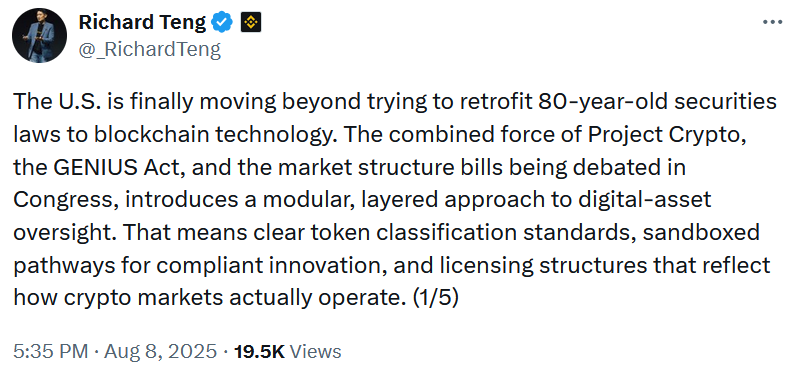The US officially has its first federal law for stablecoins. After a historic vote in the House of Representatives on July 17, 2025, President Donald Trump signed the Guiding and Empowering Nation’s Innovation for US Stablecoins (GENIUS) Act into law the following day. This created a new rulebook for dollar-pegged digital assets.
The legislation brings legal certainty to a market that analysts project could grow from $270 billion to more than $3 trillion by 2030. At its core, the law is an assertive push to put consumer protection front and center.
But while it puts up strong new walls, it also creates significant trade-offs. The GENIUS Act lays out a clearer, safer path for stablecoin issuers, but it leaves major risks on the table and points the industry toward a future that feels more like traditional banking than decentralized finance.
More Safeguards for Consumers
The GENIUS Act fundamentally changes the rules for any entity wishing to issue a dollar-backed stablecoin in the US. It pulls the sector out of a legal gray area by creating a detailed federal playbook grounded in transparency and accountability.
As Richard Teng, CEO of Binance, the world’s largest cryptocurrency exchange, explained in a recent post on X, “The U.S. is finally moving beyond trying to retrofit 80-year-old securities laws to blockchain technology. The combined force of Project Crypto, the GENIUS Act, and the market structure bills being debated in Congress, introduces a modular, layered approach to digital-asset oversight. That means clear token classification standards, sandboxed pathways for compliant innovation, and licensing structures that reflect how crypto markets actually operate.”

A core requirement of the law is that issuers must back their tokens one-to-one with high-quality, liquid assets—specifically cash and short-term US Treasury bills. To ensure this, issuers must face independent audits and provide monthly public disclosures of their reserves.
This provision hits directly at one of the industry’s most persistent anxieties: the quality and sufficiency of the assets backing major stablecoins.
Issuers are also now officially classified as financial institutions under the Bank Secrecy Act. This means they must follow the same anti-money laundering and sanctions compliance rules as traditional banks. It’s clear move—designed to choke off illicit use.
Protections are also extended to consumers for a worst-case scenario. If an issuer becomes insolvent, stablecoin holders are given priority over all other creditors, creating a crucial backstop that did not previously exist.
In a move to further shield consumers, the legislation explicitly bans issuers from offering yield on their stablecoins. This prevents digital dollars from being marketed as interest-bearing investments and reinforces their intended function as pure payment instruments. The framework also carves out riskier models entirely, with algorithmic stablecoins excluded from the new regulatory perimeter pending further study.
Multiple Trade-Offs Still Remain
Despite these robust safeguards, the GENIUS Act is not a silver bullet for all the risks inherent in stablecoins. Critics point out that significant vulnerabilities remain, starting with the very real possibility of a stablecoin losing its peg.
Even with full collateralization, depegging is a threat. As Davide Oneglia, a macroeconomist at TS Lombard, told MarketWatch, stablecoins are “not 100% safe for sure,” calling the potential for failure “a design flaw.”
The brief depegging of Circle’s USDC in March 2023, after it revealed exposure to the failed Silicon Valley Bank, serves as a sharp reminder that even well-backed stablecoins are susceptible to market shocks.
A key reason for this fragility is the lack of a lender of last resort. In the traditional financial system, central banks can inject emergency liquidity to prevent bank runs. Stablecoin issuers have no such backstop.
A large-scale redemption event could force an issuer to sell its Treasury reserves into a panicked market, potentially at fire-sale prices. This could trigger a depeg or the issuer’s insolvency in an extreme scenario. As Moody’s Ratings analyst Rajeev Bamra noted, the law provides a “necessary compliance baseline.” But ultimate stability still hinges on an issuer’s own governance and operational resilience.
The ban on yield also represents a major trade-off, one that appears influenced by the traditional banking lobby. NYU professor Austin Campbell says financial institutions actively lobbied to block interest-bearing stablecoins—they saw them as a direct threat to their deposit-based business model.
The ban protects consumers from certain investment risks. But it comes at the cost of stifling innovation and removing a major incentive to hold stablecoins. This move effectively clears the runway for competing products. Tokenized money market funds and other competing products can still offer yield and now operate with a distinct advantage.
The act’s narrow focus on fully collateralized and non-yielding stablecoins pushes more experimental and decentralized models to the fringes. The law solidifies a specific vision for stablecoins at the expense of DeFi innovation by codifying a framework that favors centralized and bank-like issuers.
A Regulated but Complicated Future
The GENIUS Act is a major turning point for digital assets. It provides the kind of clear rules and strong consumer safeguards that market participants have been calling for.
But this newfound certainty comes with a cost. The framework leaves major systemic risks, like the absence of a lender of last resort, completely unaddressed.
For issuers, there’s now a clear path to legitimacy, and users get more confidence that their digital dollars are backed by secure assets under federal watch. But this clarity comes with a price tag. The law sidesteps major systemic risks—chief among them, the absence of a lender of last resort.
Its restrictions on yield and its exclusion of decentralized models effectively channel innovation toward a more conventional, bank-centric future. The GENIUS Act has decisively ended the era of unregulated stablecoins in the US, but in doing so, it has drawn clear lines in the sand, creating a safer but more constrained environment.
The industry’s next chapter will be defined by how it evolves within these new walls.
